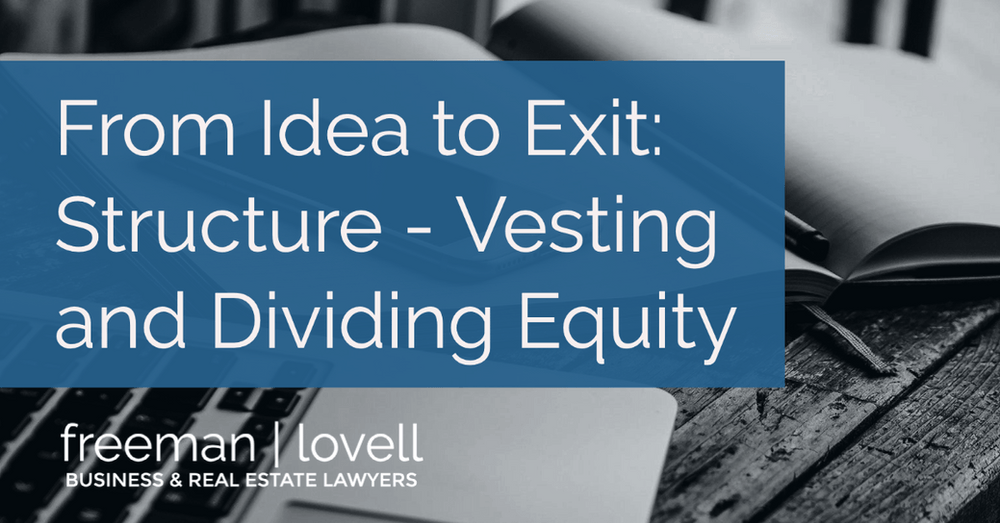
At Freeman Lovell, the success of entrepreneurs and small businesses is our goal. Whether you are a tech founder, real estate investor, or creative professional, our business lawyers are here to help you avoid common legal traps and take the right risks to take your business from idea to exit.
A common question our business attorneys get is how to split up equity between the founders of your business. This article will discuss: (1) a formulaic way to divide up equity among your founders, and (2) how to determine how to properly use vesting.
Think Long Term
Before we jump in head first on equity splits and vesting, I want to discuss several guiding principles to keep in mind as you figure out your equity split. The first is to think long term. Imagine your business in 10 years after ups and downs but plenty of growth and success. How much is your business worth? One million, fifty million, or an easy billion? When you imagine your business at what it could be and not what it is when you start, it’s easier to understand how much equity is 10%, 20%, or more. It’s also easier to understand why vesting, even for founders, is so important.
The Success of the Business Is The Big Picture
The next guiding principle is to think of your business as a living, breathing organization more important than the owners. Keeping that in mind, your business should be divided up and equity reserved to account for future growth, future needs, and future success.
Dividing the Pie
Dividing up equity is much like baking and cutting up a pie. You should consider several ingredients when dividing up equity between founders.
Ingredients
Typical ingredients of starting any successful business are the following: the idea, the cash & property, the connections, the marketing, and the services and execution. Like the ingredients in a recipe, you should allocate a percentage of the cap-table pie to each of them.
, The Idea
A percentage of the equity should go to the founder or founders that had the idea. In my opinion, this ingredient should make up between 10% and 20% of the company. The idea is also a part of the business that is being fully contributed from the business’s outset and should not be attached to any vesting requirements.
, The Cash & Property
If any of the founders are contributing cash or property, either tangible or intellectual property, those founders should receive a percentage of fully-vested equity in the business. This amount will vary significantly based on the amount of cash or the value of the property contributed.
, The Execution and Services
The long, hard work to build the foundation of a business that can scale is not trivial and should be compensated accordingly. In my opinion, I believe that majority of a company should go in this bucket. Of course, you don’t want to give all the equity up for a promise of hard work, and this is the area where I see the most mistakes made. I have seen instances when entrepreneurs give a cofounder a considerable amount of fully-vested equity. Then the partner just stops working, leaving you stuck with a deadweight co-founder and no way to reduce their equity accordingly. Don’t let this happen. All equity you allocate to a founder for the services they will provide should be subject to vesting.
, The Expertise
Some businesses will need specific skills or unique expertise to be successful. Sometimes this required expertise will be technical, professional, or experience-based. Regardless, there is value in this expertise, and you should compensate it with equity. Typically, this expertise will need to be applied over time for it to be valuable, and for that reason, this equity should not be vested upfront but slowly over time.
The Connections
In some circumstances, you may have a person that brings significant industry connections or influence that you would like to be part of your founding team. There is real value behind these connections for the long term success of your business. A founder that puts those connections to work and jumpstarts a business should be compensated with equity accordingly. Like expertise, because these connections will need to be nurtured consistently over time. For that reason, this equity should also vest over time.
Reserved Equity for Future Executives and Employees
Now that you have figured out how to divide up equity between founders, you need to take another look at the long-term vision for the company. Are you going to need to grant more equity to employees, future executives, employees, or other key partners? If you answer yes to this, you will want to set aside a pool of equity for them. You may need to give them sufficient equity to attract that kind of talent. Companies that plan on using equity to attract employees will often set aside an additional 10% to 20% of the company’s equity to grant when bringing on others in the future.
Control Considerations
As you go through and divide up the pie considering the above ingredients, one other consideration that you need to consider is how the divided up equity will affect the owners’ decision-making. You should think through how the percentages would affect decisions both on a majority and supermajority basis. Founders are regularly giving themselves amplified voting rights by putting in their operating agreements or bylaws that the founders have two votes or more per share and everyone else just one vote per share.
Vesting
Why Vesting
As we touched on above, vesting is very important. Vesting allows you to control the ownership of equity over time to ensure that a founder, employee, or advisor keeps acting in the company’s best interest. Vesting ensures that if they lose interest and stop providing services, you can claw back some of the equity that they didn’t earn by failing to provide services for the length of time you expected for the amount of equity granted.
So why not just give out equity grants every year or at the end of the services are provided? Well, it comes down to taxes. If you make separate grants at the end of each year, the grantee will need to pay taxes on the business’s increasing value, or the option or profits interest strike price would be higher and higher each year. If you grant them a larger percentage early in the company when the company is worth very little, with a long term vesting schedule, that equity owner can file an 83(b) election and pay very little tax.
Time-Based vs. Performance-Based
There is a regular debate of whether to use time-based vesting or performance-based vesting. For me, nine times out of ten, err on the side of time-based. Here are the basics of both:
Basics of Time-Based Vesting
The industry standard is the 4-year vest, one year cliff. This structure has nothing to do with clothing and even less to do with geography. What this means is that the equity granted is going to vest over four years. So what in the world is the one-year cliff? The one-year cliff means no equity vests until the grantee provides a full year’s services to the company. An employee who has this vesting schedule is required to stay for all 12 months of the first year to get anything, and then after that, equity will vest monthly. This vesting structure is a mechanism to prevent short-term employees from having any long-term interest in the company. As a business lawyer, I like this vesting structure because it is straightforward and easy to track and calculate. I like this as a business attorney because it is difficult to dispute the vesting calculation. There is nothing a corporate attorney hates more than a dispute over a contract that they drafted.
Basics of Performance-Based Vesting
There is no industry standard when it comes to performance-based vesting. Generally, performance-based vesting is based on the company or employee meeting some financial or numerical criteria. Performance-based vesting sounds fine and good, but is it? Here are three top-of-mind reasons I don’t like this type of vesting:
- Accounting for numbers and dollars can easily be, and are, regularly disputed.
- Performance-based vesting doesn’t take into account environmental factors that can affect financial performance.
- Employees and founders often change roles as the business grows and changes, and the financial or numerical metrics may no longer make sense or incentivize the right things.
One type of performance-based vesting that I am okay with is when hourly and monetary contributions are predetermined, tracked, and calculated for the founders. Performance-based vesting is a good structure for businesses made up of founders who have other full-time jobs. How this works is that you grant 1,000,000 units/shares, and each year, 200,000 of those units/shares can vest based on the hours and dollars contributed by the grantee.
Conclusion
If you take anything away from this, I hope it is this: Think long term. Use vesting with any amounts of equity that the grantee should earn over time. Give fully vested equity for the business concept and actual cash and property contributed.
If you want some help getting this figured out for your business, don’t hesitate to contact one of Freeman Lovell’s business attorneys. We can help you.
Call or text us at (385) 217-5611 or send us a message through our Contact Form .
Want to know more?
Check out our YouTube channel and see more videos like the one below:




